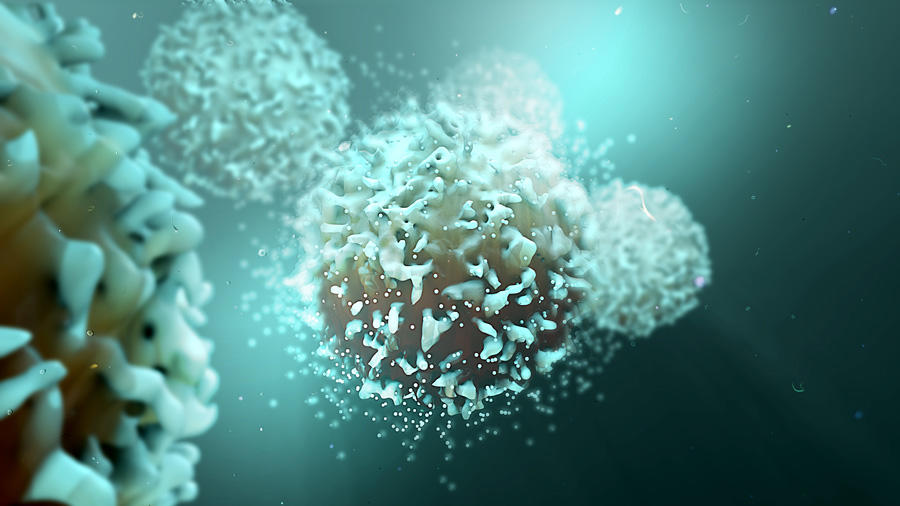Harnessing T-cell “stemness” could enhance cancer immunotherapy
- Posted:
240-760-6600
A new study led by scientists in the Center for Cancer Research (CCR) at the National Cancer Institute (NCI) sheds light on one way tumors may continue to grow despite the presence of cancer-killing immune cells. The findings, published March 29, 2019, in Science, suggest a way to enhance the effectiveness of immunotherapies for cancer treatment. NCI is part of the National Institutes of Health.
Dying cancer cells release the chemical potassium, which can reach high levels in some tumors. The research team reported that elevated potassium causes T cells to maintain a stem-cell-like quality, or “stemness,” that is closely tied to their ability to eliminate cancer during immunotherapy. The findings suggest that increasing T cells’ exposure to potassium—or mimicking the effects of high potassium—could make cancer immunotherapies more effective.
“This study helps us better understand why cancer immunotherapy works the way it does,” said Nicholas Restifo, M.D., of NCI’s CCR, who led the research team. “It could also point the way toward generating better and more long-lasting responses to these treatments.”
Immunotherapy has led to remarkable results for some patients’ cancers, eradicating difficult-to-treat tumors and, in some cases, causing complete remission of disease. But many patients’ tumors do not respond to immunotherapy treatments, and researchers are working to determine why this is.
In addition, some immunotherapy treatments, such as CAR T cells and immune checkpoint inhibitors, are limited by the life span of T cells. Cancer-fighting T cells inside the tumor can get “exhausted” and die. Therefore, researchers are exploring ways to help T cells used for immunotherapy not only last longer but replicate and grow.
Dr. Restifo and his team previously established that high levels of potassium inside tumors released by dying cancer cells can shut off cancer-killing T cells that have invaded the tumor. In the new study, the researchers showed that growing T cells under conditions of high potassium also preserves the “stemness” of the T cells. This means that, in the tumor, the stem-cell-like T cells have the ability to replicate themselves, but they aren’t able to mature into killer immune cells. By keeping T cells in this state, the tumors can avoid attack and continue to grow. This could explain how a cancer could grow despite the presence of T cells that would seemingly be able to fight the cancer.
However, when the stem-cell-like T cells are removed from the tumor, grown to large numbers in the lab, and then returned to the patient—as they are in a primary immunotherapy strategy called adoptive cell transfer—the stem-cell-like T cells can mature into killer cells that can attack the tumor. The preserved stemness of T cells—that is, their ability to self-renew indefinitely and respond to stimulation to become cancer-fighting cells—may be what allows adoptive cell transfer therapy to be successful, Dr. Restifo explained.
The researchers next explored preserving T cells’ stemness with high potassium levels for therapeutic use. They found that T cells grown in the presence of extra potassium and transplanted into mice shrank primary and metastatic melanoma tumors better than T cells grown in normal levels of potassium. They also found that, when exposed to a high concentration of potassium, both T cells isolated from patient tumors as well as genetically engineered anticancer T cells had higher levels of markers associated with continued growth and improved immunotherapy outcomes.
Finally, the research team demonstrated that when they used specific drugs to mimic potassium’s effects on T cells in mice, this improved the T cells’ ability to continue to grow and eliminate tumors. This means that such a drug could potentially be used to induce stemness in T cells as a strategy to enhance cancer immunotherapies.
Dr. Restifo said that the next step will be clinical trials “to use this knowledge to make better treatments,” but he is also excited about what the findings add to our current understanding of immunotherapy.
“What we’ve done is, we’re harnessing the stemness capacity of T cells to treat cancer,” he said. “For us, it’s huge. It explains how some immunotherapies work and suggests how we can improve them.”
This press release describes a basic research finding. Basic research increases our understanding of human behavior and biology, which is foundational to advancing new and better ways to prevent, diagnose, and treat disease. Science is an unpredictable and incremental process—each research advance builds on past discoveries, often in unexpected ways. Most clinical advances would not be possible without the knowledge of fundamental basic research.
About the Center for Cancer Research (CCR): CCR comprises nearly 250 teams conducting basic, translational, and clinical research in the NCI intramural program—an environment supporting innovative science aimed at improving human health. CCR’s clinical program is housed at the NIH Clinical Center—the world’s largest hospital dedicated to clinical research. For more information about CCR and its programs, visit ccr.cancer.gov.
About the National Cancer Institute (NCI): NCI leads the National Cancer Program and NIH’s efforts to dramatically reduce the prevalence of cancer and improve the lives of cancer patients and their families, through research into prevention and cancer biology, the development of new interventions, and the training and mentoring of new researchers. For more information about cancer, please visit the NCI website at cancer.gov or call NCI’s Contact Center, the Cancer Information Service, at 1-800-4-CANCER (1-800-422-6237).
About the National Institutes of Health (NIH): NIH, the nation's medical research agency, includes 27 Institutes and Centers and is a component of the U.S. Department of Health and Human Services. NIH is the primary federal agency conducting and supporting basic, clinical, and translational medical research, and is investigating the causes, treatments, and cures for both common and rare diseases. For more information about NIH and its programs, visit nih.gov.
